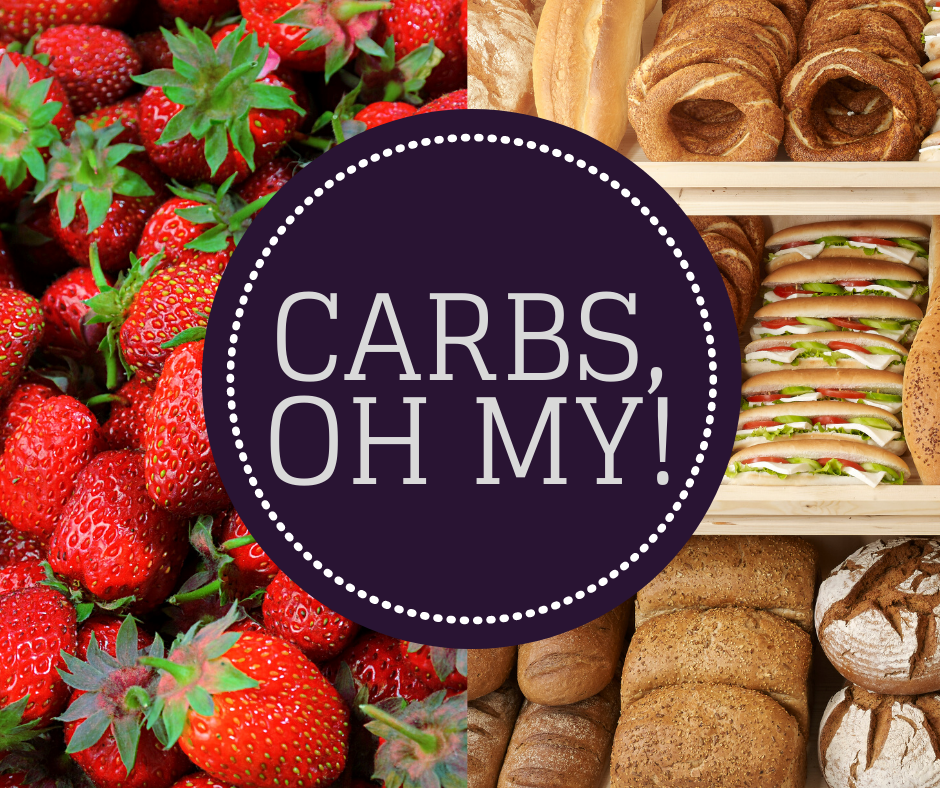As a nutrition coach, I hear all sorts of things during my conversations with clients, friends, and strangers. Lots of these things are food myths and reasons given for why a particular diet/nutrition strategy/nutrient restriction has either worked (or not), for themselves or someone else.
“I’m off bread” … “Eating clean and doing juice cleanses helped to drop X amount of weight in a week” … “I’m addicted to carbs, so I just avoid eating any at all…once I start, I just can’t stop”
Table of Contents
ToggleWhat are Carbs?
Carbohydrates are one of the main macronutrients where we derive energy (i.e. calories) from in our daily diet. Carbohydrates are the sugar, starch, and fiber molecules that come from fruits, vegetables, grains, and dairy products. Carbs are found in healthy and unhealthy foods alike, and are often made the scapegoat for weight gain, but I promise you it’s not carbs that are the problem.
Our body requires that we give it energy to perform basic functions, like breathing, sleeping, digesting, sitting, etc. ‘Calorie’ is the unit of measurement that we give to our body’s fueling and energy system – and carbohydrates are one of the body’s sources of energy, along with protein and fat (and alcohol…but let’s not dive into that today).
When we look at macronutrients, each has their own caloric value:
Protein → 1g = 4calories
Carbohydrates → 1g = 4calories
Fat → 1g = 9cal
What do you notice about the breakdown above? Fat is over twice as energy dense as protein and carbs. Remember that…we’ll be discussing it further later on this article.
Simple vs. Complex Carbs

When it comes to carbohydrates, we categorize them by the body’s swiftness in processing and breaking the carbohydrates down into fuel. Simple carbs are usually found in sugars from fruits and dairy products, and complex carbs come from the starches and fibers in vegetables and grains.
Naturally-occuring sugars are also packed with micronutrients such as vitamins, minerals, and fiber that the body needs to function properly. Simple sugars can be obtained from highly-processed sugars found in candy, syrup, etc. that have been stripped of any micronutrients…now those are the ones you want to be on the lookout for.
Often referred to as ‘empty calories’, they are found in highly-processed foods that are high in calories and low in essential nutrients like vitamins, fiber, and minerals.
But Bread…isn’t it bad?
No, bread isn’t bad. It’s not off-limits. If you’re diagnosed with Celiac disease or gluten-intolerant, then yes. Traditional gluten-laden bread is very bad for you. But just because one food or nutrient is bad for a very small portion of the population doesn’t mean that it’s a ‘bad’ food. Go take a look at my recent article discussing the Gluten-Free Myth.
For my own calorie budget and macro goals, I don’t choose to have bread very often because regular bread tends to be fairly calorie dense for a low volume of food to eat…
…meaning that I don’t always feel satiated eating a slice of bread despite the high calorie amount per serving. For example, one slice of enriched white bread will be anywhere from 80-120cal, about 1g of fiber, 2g of sugar, and 15g total carbs.
If you love bread, or like me, you love a piece of toast or a sandwich every once in a while, there are more nutritious (and calorie-friendly) options to choose from in the bread aisle! Dave’s Killer Bread is a really delicious whole grain bread company that makes a great sandwich or toasting bread in a variety of flavors and types of breads (bagels, English muffins, thin-sliced loaves, regular-sliced loaves).
Can you really ‘crave’ carbs?
Let’s talk about the palatability of food. It’s a big word so I will do my best to describe it simply. Palatability refers to the acceptableness or pleasure derived from a food in the mouth, most often the taste. Highly-palatable foods are often foods that combine (natural or processed) sugars or fat with salt and/or flavorings:
- Chips and French Fries
- Peanut Butter
- Ice Cream
- Doughnuts and Pastries
- Candies and Sweets
- Pizza and Pasta
Now, it’s not that you are actually craving carbs, but that eating highly-palatable foods actually send chemical signals to your brain and rewards you by releasing neurotransmitters like dopamine and serotonin which make you feel good while you’re eating high-sugar and high-fat foods. There’s a reason why we call certain things comfort foods… Also, the satiety response when eating highly-palatable foods is dampened which will often lead to overindulging because we don’t realize that we’re actually full.
If I told you to eat as many apples, broccoli, or plain steamed white potatoes as you would like, you would likely get full and stop eating those carbs. So, it’s not the carbs that you’re addicted to. It’s the combination of carbohydrates and fat that is causing you to feel out of control when you’re eating highly-palatable foods like I described above.
Should I just never eat highly-palatable foods?
Nope! Restricting a certain nutrient, or category of food (sugar, bread, etc.) is more often going to lead to disordered eating habits such as perpetuating the ‘diet’ mentality, the good vs. bad dichotomy assigned to food, and is not sustainable for a healthy lifestyle.
Making mindful choices when selecting food at the grocery store, like not choosing to purchase a sugary cereal and opting for eggs and toast instead for breakfast during the week is a great example of being able to include a highly-palatable food (i.e. bread) in your daily nutrition strategy and still progressing towards your scale goals.
I always let my nutrition clients know that there are no foods that should be considered ‘off-limits’ and our healthy nutrition strategy should allow you to still enjoy those highly-palatable foods from time to time all while still seeing your scale weight and physique change towards your dream body.
Fear carbs no more – here’s why:
Carbohydrates are a quick way to provide your body with the fuel you need to perform not only basic life functions, but also in the gym while you’re training. Do you ever find yourself just absolutely dragging in your workout? Or maybe feeling drained, light-headed, or weak near the end or right after your training session? As long as you don’t have a pre-existing medical condition, I would challenge you to look at your carbohydrate consumption in the 60-90 minutes prior to your workout. Try adding a small granola bar, piece of toast, oatmeal, fresh fruit, or Gatorade and tell me it doesn’t improve your performance in your next training session…
Aside from the performance improvements that will be made by increasing your carbohydrate consumption around your workouts, including low-calorie carbs like fresh veggies and fruits is a great way to increase the volume of food you’re eating while you’re in a calorie deficit (in order to lose weight). Having those foods readily available in your fridge and pantry will be a gamechanger, because if you have the right choice on hand when you are feeling a bit snacky or hangry you won’t make a misstep with your calorie budget.
Are you ready to give up your diet lifestyle, and learn how to eat the foods you love while you lose weight? Let’s set up a nutrition consultation – email [email protected] to take your first step towards building a healthier lifestyle for the rest of your life TODAY!



